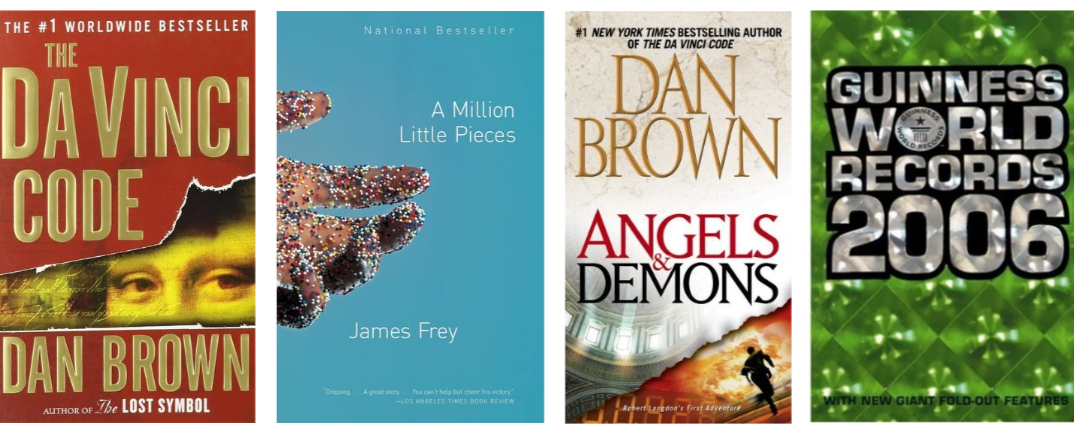This month, we’re talking all about movies and TV shows. Specifically the ones based on books. Our newest research report, out today, Must-Watch, Must-Read: Book-to-Screen Adaptations in the Canadian Book Market 2022 gives you all the information we’ve been asked for and that you’ve been looking for about the impact that TV and movie adaptations have had on book sales and library circulation!
(Scroll down for a transcript of the episode.)
Want to make sure you never miss an episode of the podcast? You can subscribe for free on iTunes, Stitcher, Pocket Casts, TuneIn, or SoundCloud.
Further reading/listening
Transcript
Ainsley Sparkes: Welcome to the BookNet Canada podcast. I’m Ainsley Sparkes, the Marketing & Communications Manager and the host of this month’s episode.
This month, we’re talking all about movies and TV shows. Specifically the ones based on books. Books used as source material for films has been always been popular, but according to The Atlantic, the number of books adapted into TV shows has only increased over the last decade.
Our newest research report, out today, Must-Watch, Must-Read: Book-to-Screen Adaptations in the Canadian Book Market 2022 gives you all the information we’ve been asked for and that you’ve been looking for about the impact that TV and movie adaptations have had on book sales and library circulation!
In this free report we answer the question, do movie and television adaptations make a difference in terms of book sales and library circulation for their source material? Our intrepid Research Coordinator, Aline Zara, looked at data related to 30 television shows and 60 movies to find out. (For the full details of the methodology consult the study.)
So do they make a difference? Turns out yes: Titles adapted into television shows and films saw increases in both sales and library circulation, with titles adapted into television shows seeing the majority of sales and library holds. Sales for titles adapted into TV shows peak the week of the show’s release, whereas, library loans and holds increase more gradually but steadily, and this starts in the lead up to the release of the show and continues in the weeks after.
For movies, library loans for movie titles were pretty much flat in the weeks leading up to and the weeks after a movie’s release. Library holds, however, had a significant increase of 35% between the fifth and sixth week after the films were released, and reached their peak at the tenth week post-release. Movies seem to be a slower burn in libraries.
Sales, on the other hand, peak the week of the film’s release, but decline more sharply immediately after — perhaps because unlike a TV show, which takes more time to watch and may even be released over several months, a movie is (likely to be) a one-time viewing event.
Other high level findings from the study: As you maybe would have guessed, COVID-19 had an effect on the sales and library circulation of titles related to book-to-screen adaptations in 2020, with pandemic restrictions impacting Canadians’ access to bookstores, libraries, and movie theatres. In the study we compare and contrast sales trends and library loans and holds in 2020 and 2021 to show the effect in more detail.
The title chosen for the adaptation makes a difference a well — a Fiction title that belongs to a book series tended to be the most successful.
Of the 30 TV shows we tracked, 60% were based on Fiction titles, 30% Non-Fiction, and only 10% Juvenile and Young Adult titles. Of the Fiction titles, the most popular BISAC subject was Thrillers. And the most popular Non-Fiction subject was COMICS & GRAPHIC NOVELS / Superheroes.
For the 60 movies, the subject matter of the source material was more evenly spread out: 42% were Fiction titles, 32% Juvenile and Young Adult, and 27% Non-Fiction. Thrillers remained the most popular BISAC subject for all the Fiction titles, and COMICS & GRAPHIC NOVELS / Superheroes remained the most popular Non-Fiction subject. It seems people can’t get enough twists, turns, and thrills from their books or on their screens.
The adaptation itself, the TV show or the movie, also influences the sale of its source material — a highly rated adaptation, released in the fourth quarter of the year seemed to have the best reception, especially if the film had a theatrical release or if the television show was released all at once.
Important dates in an adaptation’s process — casting and filming announcements, trailer releases, and the like — all supported the sales and library circulation of titles adapted into television shows and films.
The full study has so much more detail on all of the above and also includes four case studies of book to screen adaptations — two TV shows, Bridgerton based on the Bridgerton series by Julia Quinn and Maid based on Maid: Hard Work, Low Pay, and a Mother's Will to Survive by Stephanie Land and two movies, Dune based on the book of the same name by Frank Herbert and The Witches based Roald Dahl’s work of Juvenile Fiction.
So if you want to learn even more than this brief overview, I highly recommend checking out the full study. And, if that’s not enough, we’ve also got some bonus content on our blog all about Movie Tie-In editions and how they perform in stores and in the library.
Thanks for joining us this month. Before we go, I’d like to take a moment to acknowledge that BookNet Canada staff, board, partners, and our makeshift podcast studio, operate upon the traditional territories of the Mississaugas of the Credit First Nation, the Anishinaabe, Haudenosaunee, and Wendat Indigenous peoples, the original nations of this land. We endorse the calls to action from the Truth and Reconciliation Commission of Canada and support an ongoing shift from gatekeeping to space-making in the book industry. And we hope that our work, including this podcast, helps to create an environment that supports that shift. We'd also like to acknowledge the Government of Canada for their financial support through the Canada Book Fund. And of course, thanks to you for listening.














The latest news out of the European Commission.